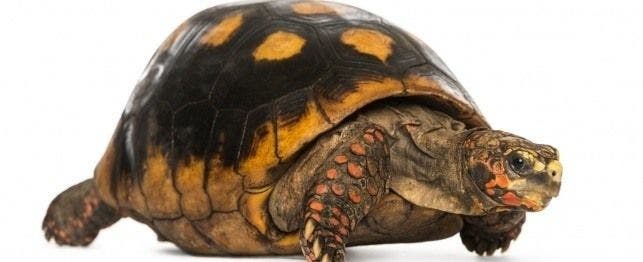
Choosing a Red-Footed Tortoise
Tortoises count among their numbers such giant species as those of the Galapagos and Aldabra Islands, tiny types such as the 4-inch long parrot-beaked tortoises of South Africa, and a number of species of intermediate size. With the exception of a few years, the moderately sized red-footed tortoise has been a mainstay of the pet trade for about 40 years.
Currently imported from Venezuela and other South American countries, the red-foot is also bred in fair numbers by hobbyists. Although it is the hatchlings and juveniles that are most often seen in the pet trade, some adults are usually also available.
Hatchling red-footed tortoises are usually available in small numbers throughout the year. Although tortoises do not grow quickly they do continue to grow when actively feeding. When well cared for a life span of 30 to 50 years is not an unreasonable expectation.
Behavior
Red-foots are moderately large tortoises with a heavy, well-formed shell. They become very tame and trusting but do not like to be lifted. Like most tortoises, they are essentially terrestrial, but on hot days may enter shallow water to soak and attempt to cool down. They bask extensively, usually in the morning or late afternoon, as temperatures are warming or cooling. They actively forage throughout much of the day. Red-foots are gentle tortoises that seldom attempt to bite.
Until fully acclimated, red-foots may withdraw into their shell, heavily scaled forelimbs folded across and protecting the opening for the withdrawn head, and remain immobile for many minutes. When they begin to relax they do so slowly, and are ready to withdraw again if startled in the slightest.
Appearance
There are several geographic variations of this tortoise. Those from Colombia are often dumbbell shaped when viewed from above. The red-foots from central eastern South America are of small size, brilliantly colored, and often referred to as “cherry-heads.” Bolivia is the home of a very large (to 18-inch carapace length) form that is moderately brightly colored.
The enlarged red to red-orange scales on the anterior of the front legs and the similar color on the head, make this a rather easily recognized tortoise species. The highly domed carapace is dark with light scute centers, the plastron is light, often with dark smudges. There are well-defined sculptured growth rings both on the upper and lower shell scutes. The limbs are strong and well clawed. In shape the rear feet are rather like those of the elephant.
Feeding
Although it is primarily herbivorous, red-footed tortoises seem to consume more animal protein than many other tortoise species. They should be fed a diet of mixed, healthy greens (collards, mustard, beet, and dandelion greens, romaine, lettuce, escarole, bok choy), some fruits, some commercial tortoise foods and, occasionally (once or twice a week), a little low-fat kibble dog food. Because spinach contains oxalic acid, a calcium binder, we suggest it not be fed to the tortoise. In captivity, where exercise is limited, even on a healthy diet, some tortoises can become unnaturally fat. Regulate the amount of food given. Obesity is no healthier for a tortoise than for a human.
A sizable shallow container of fresh drinking water should always be present.
Housing
One or two hatchling red-footed tortoises may be kept in a 15-gallon terrarium with mulch or rolled corrugate bedding. As the tortoise grows the size of its terrarium will also need to increase. One or two adult red-foots will need a cage having a bottom space of 4-foot x 8-foot (the size of a sheet of plywood). They will require a retaining wall of about 18 inches around the perimeter of the cage, but will not need a top.
During the daylight hours, illuminate and warm one end of the cage. An ambient cage temperature of 76 to 82 degrees Fahrenheit is fine, but a hot spot warmed to 95 to 100 F by a full-spectrum UV-B-heat bulb is recommended. Nighttime temperatures can drop by a few degrees and the heat bulb turned off. Provide a shallow but sizable water receptacle for your tortoise to drink from and soak in. Since many tortoises regularly defecate in their water receptacles, be prepared to change this as necessary.
Garden pens, greenhouses and spare rooms can also be adapted as a tortoise home.
Medical Issues
- Pneumonia
- Dystocia (egg-binding)